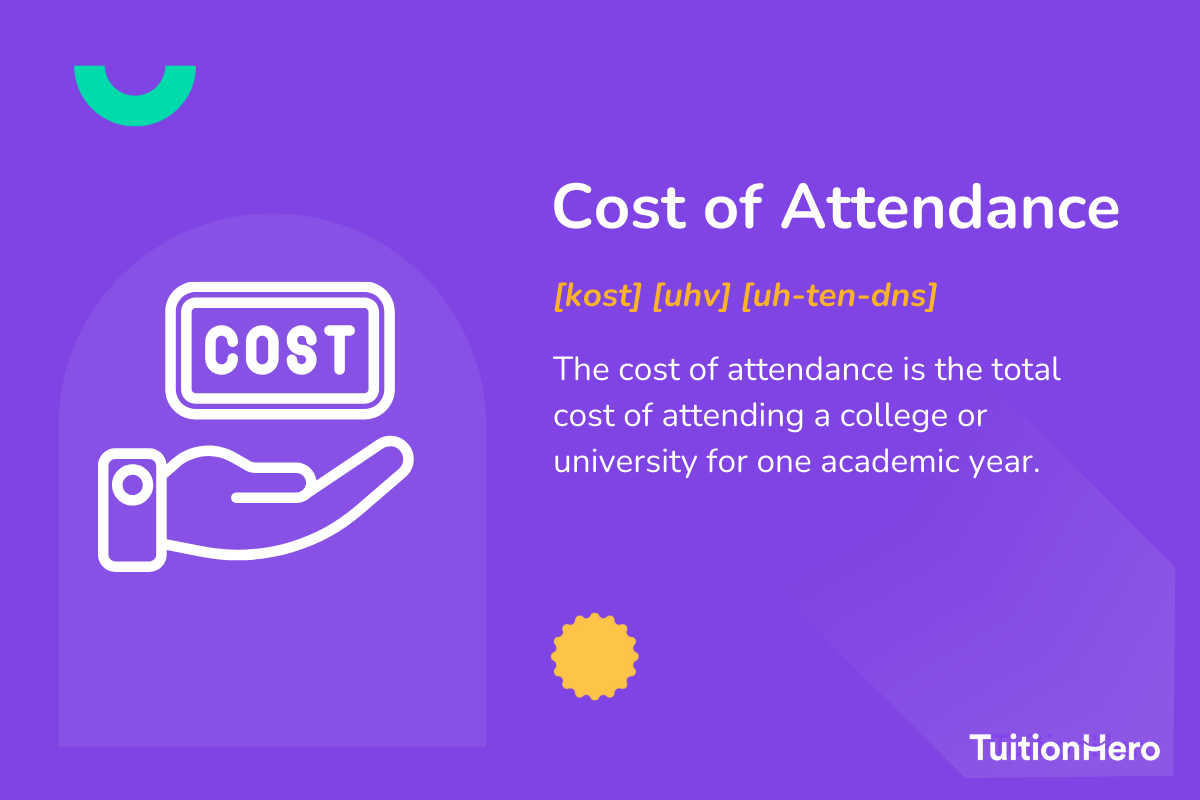Advertiser Disclosure
Last update: November 17, 2024
8 minutes read
What is Cost of Attendance (COA)? What to Know in 2024
Do you know what your school's true COA is? Let's explore the ins and outs of college cost of attendance. Dive into loans, aid, and smart strategies to navigate college finances.

By Brian Flaherty, B.A. Economics
Edited by Rachel Lauren, B.A. in Business and Political Economy
Learn more about our editorial standards



By Brian Flaherty, B.A. Economics
Edited by Rachel Lauren, B.A. in Business and Political Economy
Learn more about our editorial standards
College can be a transformative experience, but what about the cost? That's a whole different story. So, how do you navigate the financial maze and make the best choices for your future? Let's break it down and take the mystery out of one of the most crucial terms you'll come across: the Cost of Attendance (COA).

Key takeaways
- The Cost of Attendance (COA) is the estimated annual total of all college expenses and is crucial for determining financial aid eligibility
- COA varies based on factors like living situation and whether a student attends an in-state or out-of-state school
- Financial aid is calculated using the COA and the Expected Family Contribution (EFC), with borrowing limits in place
What is Cost of Attendance (COA)?
Cost of Attendance (COA) is the estimated yearly total of all your college expenses, including tuition, room and board, and books. In essence, it's the "sticker price" of your college journey used to determine your eligibility for financial aid.
It's the total bill you'd pay if you didn't score any financial aid. We're talking tuition, room and board, books, and those random supplies you didn't think you'd need.

Real-life example
Imagine two students, Alex and Jamie, attending the same university. Alex lives on campus, while Jamie commutes from home. Their COAs will differ because Alex's room and board costs add to the total expenses, whereas Jamie saves on housing but might incur transportation costs.
What's included in the COA?
When colleges whip up their COA, they're not just pulling numbers out of thin air. Federal law mandates what they've got to factor in. Here's a breakdown:
- Tuition and fees: your ticket to those lectures and labs.
- Room and board: whether you're living the dorm life or off-campus.
- Books and supplies: those pricey textbooks and maybe a fancy calculator.
- Transportation: gas, bus passes, or those flights back home.
- Personal expenses: Miscellaneous costs like laundry, cell phone bills, and personal items.
Expense Category | Description |
|---|---|
Tuition and Fees | Cost per credit hour, lab fees, technology fees. |
Room and Board | On-campus housing vs. off-campus living costs. |
Books and Supplies | Textbooks, software, lab equipment. |
Transportation | Commuting costs, travel home during breaks. |
Personal Expenses | Clothing, entertainment, toiletries. |
Now, it's crucial to remember that the COA is your college's version of the Manufacturer's Suggested Retail Price (MSRP) for cars. It's the asking price. But just as you'd haggle when buying a car, you can apply for financial aid when paying for college, which could mean you end up spending less than the COA.
Can COA vary?
Picture this: two students, both attending the same university. One's in a campus dorm, the other's commuting from their childhood bedroom.
Their COAs? Definitely not twin-sies. Colleges often create different COAs based on living situations.
And if you're an out-of-state student? Buckle up, because that COA might just take you for a ride - attending out-of-state is often more expensive than an in-state school.
Additional factors affecting COA:
- Program of study: Some majors, especially STEM fields, may have higher COAs due to lab fees and specialized equipment.
- Part-time vs. full-time enrollment: Part-time students may have different COAs compared to full-time students.
- Special programs: Study abroad programs or dual-degree options can alter the COA.
And here's another curveball. Some colleges slice and dice their COAs into:
- Billable charges: The direct hits to your wallet, like tuition.
- Indirect expenses: Stuff you'll pay for but not necessarily to the college, like those off-campus dinners.
How does COA affect financial aid?
Remember FAFSA, that form you filled out? It's the golden ticket to determining how much financial aid you can get. Here's how it works:
- College gives you their COA.
- Provided you filled out the FAFSA form, the Department of Education responds with your Expected Family Contribution (EFC) – soon to be called the Student Aid Index (SAI). As the name suggests, it’s the amount the folks over at the government believe your family can afford to contribute based on their income and other assets.
- College does some quick math: COA minus EFC to determine your financial need.
What does cost of attendance mean for financial aid? It means that your COA is used as a baseline to determine the amount of financial aid you are eligible for, ensuring that your aid packages are tailored to meet your specific financial needs.
Case study
Sarah fills out her FAFSA and receives an EFC of $10,000. Her chosen college has a COA of $30,000. Therefore, her financial need is $20,000, which is the amount the college will attempt to cover through scholarships, grants, and loans.

TuitionHero Tip
Now, this number doesn’t necessarily mean the school will cover all of your financial needs - every school is different in what they can afford.
The aid you're offered could include:
- Federal Pell Grants: The best kind of money. It's free!
- Specialized Scholarships: Some schools offer their own special scholarships based on merit (how well you did on high school, or as an incentive to join their sports team) or need
- Subsidized Loans: This is a loan, but the government pauses interest while you study. It only kicks in after you graduate.
- Unsubsidized Loans: Interest starts accruing as soon as you take it out, but you don’t need to start repayment until after you finish school.
- Work-study Jobs: Because who doesn't want a job in the campus bookstore?
Can I borrow more than COA?
In the world of loans, the COA is like a ceiling. You can't shoot through it.
Federal aid, grants, and loans all have a cap. They can't exceed the COA minus your EFC.
It's all about balance. So, while you might have visions of diving into a Scrooge McDuck-style vault of loan money, the reality is a bit more...grounded.
But, there's a silver lining. If federal loans and scholarships don't cover everything, private lenders might just fill the gap.
Picture them as the sidekicks in a superhero movie. Handy to have around, but with their own set of rules. Just remember, while Iron Man had Jarvis, you'll probably need a co-signer.
Strategies to stay within COA
- Budget wisely: Track your expenses and prioritize needs over wants.
- Seek additional scholarships: Look beyond federal aid for scholarships from organizations, businesses, and community groups.
- Consider part-time work: Balancing work and study can help cover extra costs without excessive borrowing.
- Live economically: Opt for shared housing, cook meals at home, and use second-hand textbooks to save money.
Case study
Mark took out federal subsidized loans totaling $15,000 for his undergraduate studies. Thanks to the subsidized interest, he didn’t accrue any interest while studying. After graduation, he entered an income-driven repayment plan, making manageable monthly payments based on his income.
Compare private student loans now
TuitionHero simplifies your student loan decision, with multiple top loans side-by-side.
Compare Rates
How to reduce your cost of attendance
Reducing your COA can significantly ease the financial burden of college. Here are some strategies to help you minimize expenses:
- Choose in-state schools: In-state tuition is generally lower than out-of-state fees.
- Live at home: If possible, living with family can save on room and board costs.
- Attend a community college first: Starting at a community college and then transferring to a four-year institution can lower overall tuition costs.
- Apply for scholarships and grants: Continuously seek out scholarships and grants to reduce the need for loans.
- Take advantage of work-study programs: Earning money while studying helps cover expenses without incurring debt.
- Choose digital textbooks: E-books are often cheaper than physical textbooks.
- Use public transportation: Save on transportation costs by using public transit or biking instead of owning a car.
Dos and don'ts of applying for student loans
Navigating the financial landscape of college can feel like a tightrope walk. Here's a quick table to help you keep your balance with some do’s and don'ts.
Dos
Research all your loan options
Understand terms and conditions
Make a budget plan for repayments
Consult financial experts
Don'ts
Dive in without comparing federal vs. private
Assume you know all the fine print
Forget about loan repayments
Rely solely on peer advice
Advantages and disadvantages of applying for federal student loans
Federal student loans, often the first go-to for college financing, come with their own set of pros and cons. While they can be a lifeline for many, it's essential to weigh the benefits against potential pitfalls.
- Lower interest rates: Typically, they offer more competitive rates compared to private loans.
- Subsidized options: The government covers the interest on subsidized loans while you're in school. That's pretty much free money!
- Flexible repayment plans: From income-driven plans to extended repayment, there's something for everyone.
- Loan forgiveness programs: In specific professions or situations, especially if you work in the public sector or non-profit, you can get forgiveness after you make a certain number of payments.
- No credit checks: For most federal loans, your credit score won't even be a factor.
- Borrowing limits: They cap how much you can borrow, which might not cover your entire COA.
- Potential for debt: It's easy to forget that loans = debt. Even with lower rates, it's money you'll have to repay.
- Complex terms and conditions: You'll need to read the fine print and understand terms like deferment, forbearance, and more.
- Impact on credit: While they don't need a credit check initially, failing to repay can tank your credit score.

Why trust TuitionHero
Feeling lost in the world of college finances? TuitionHero is your guiding light, offering a wealth of resources. From private student loans and refinancing options to scholarships and FAFSA assistance, we've got you covered. Plus, we provide solid credit card choices and financial literacy tools to help you make informed decisions.
Frequently Asked Questions (FAQ)
- Tuition & Fees: The basic charges for attending classes and using school facilities.
- Room & Board: Costs for living on campus or estimated costs for living off-campus.
- Books & Supplies: Expenses for textbooks and classroom materials.
- Personal Expenses: Miscellaneous costs like laundry, cell phone bills, and personal items.
- Transportation: Costs for traveling to and from school.
Understanding the COA helps students and families plan and budget for college. Financial aid offices also use it to determine a student's eligibility for aid.
COA is calculated by the college based on federal guidelines, considering all necessary expenses a student might incur during the academic year. Factors include tuition, housing, meals, books, supplies, transportation, and personal expenses.
Yes, the COA can change based on factors like inflation, changes in tuition rates, and other economic factors. It's a good practice to check the COA annually.
If your financial aid doesn't cover your COA, consider the following options:
- Apply for additional scholarships and grants.
- Work part-time or participate in work-study programs.
- Explore federal and private loan options responsibly.
- Reduce expenses by adjusting your living situation or course load.
Yes, online programs may have different COAs. Typically, they might have lower room and board costs but could include additional fees for technology and online resources.
It stands for Cost of Attendance, a term you’ll encounter frequently when navigating the financial aspects of higher education.
Final thoughts
Understanding your COA and the resources available to you is the key to unlocking a stress-free college experience. At the end of the day, it's not just about the numbers; it's about empowering yourself to take control of your financial destiny. And trust me, once you do, it's an insane feeling of freedom!
Sources
Author

Brian Flaherty
Brian is a graduate of the University of Virginia where he earned a B.A. in Economics. After graduation, Brian spent four years working at a wealth management firm advising high-net-worth investors and institutions. During his time there, he passed the rigorous Series 65 exam and rose to a high-level strategy position.
Editor

Rachel Lauren
Rachel Lauren is the co-founder and COO of Debbie, a tech startup that offers an app to help people pay off their credit card debt for good through rewards and behavioral psychology. She was previously a venture capital investor at BDMI, as well as an equity research analyst at Credit Suisse.
At TuitionHero, we're not just passionate about our work - we take immense pride in it. Our dedicated team of writers diligently follows strict editorial standards, ensuring that every piece of content we publish is accurate, current, and highly valuable. We don't just strive for quality; we aim for excellence.
Related posts
While you're at it, here are some other college finance-related blog posts you might be interested in.
Shop and compare student financing options - 100% free!

Always free, always fast
TuitionHero is 100% free to use. Here, you can instantly view and compare multiple top lenders side-by-side.

Won’t affect credit score
Don’t worry – checking your rates with TuitionHero never impacts your credit score!

Safe and secure
We take your information's security seriously. We apply industry best practices to ensure your data is safe.
Finished scrolling? Start saving & find your private student loan rate today



